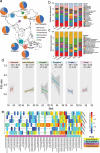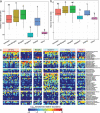Probiotic-directed modulation of gut microbiota is basal microbiome dependent
- PMID: 32200683
- PMCID: PMC7524168
- DOI: 10.1080/19490976.2020.1736974
Probiotic-directed modulation of gut microbiota is basal microbiome dependent
Abstract
As an effective means to improve quality of life and prevent diseases, the demand for probiotics and related products has increased in recent years. However, it is still unclear whether a particular probiotic strain will have similar beneficial effects on healthy adults from different regions. In this study, the probiotic Lactobacillus casei Zhang (LCZ) was consumed by healthy adults from six different Asian regions and the changes in gut microbiota were compared using PacBio single molecule, real-time (SMRT) sequencing technology based on samples collected before, during and after consumption of LCZ. Our results reveal that the effect of LCZ consumption on individuals was closely related to the composition of that individual's basal gut microbiota. A Gut Microbiota Variability Index (GMVI) was proposed to quantitatively compare the effects of LCZ on human gut microecology. Subjects from Xinjiang and Singapore regions had the highest and lowest GMVI, respectively. In general, consumption of LCZ increased the relative abundance of certain beneficial bacteria such as Lactobacillus, Roseburia, Coprococcus and Eubacterium rectale, while it inhibited growth of certain harmful bacteria such as Blautia and Ralstonia pickettii. In addition, consumption of LCZ was responsible for the conversion of some participants from Prevotella copri/Faecalibacterium prausnitzii (PF) enterotype to Faecalibacterium prausnitzii/Bacteroides dorei (FB) enterotype and consistently increased the abundance of lactic acid bacteria in the gut. It also increased/enhanced phosphate metabolic modules, amino acid transport systems, and isoleucine biosynthesis, but conversely decreased lipopolysaccharide biosynthesis. These changes could have health benefits for healthy adults.
Keywords: lactobacillus casei Zhang; Probiotics; enteropypes; gut microbiota; lactic acid bacteria.
Figures






References
-
- Ford AC, Quigley EMM, Lacy BE, Lembo AJ, Saito YA, Schiller LR, Soffer EE, Spiegel BMR, Moayyedi P.. Efficacy of prebiotics, probiotics, and synbiotics in irritable bowel syndrome and chronic idiopathic constipation: systematic review and meta-analysis. Am J Gastroenterol. 2014;109:1547–21. doi:10.1038/ajg.2014.202. - DOI - PubMed
-
- Rijkers GT, Bengmark S, Enck P, Haller D, Herz U, Kalliomaki M, Kudo S, Lenoir-Wijnkoop I, Mercenier A, Myllyluoma E, et al. Guidance for substantiating the evidence for beneficial effects of probiotics: current status and recommendations for future research. J Nutr. 2010;140:671S–6S. doi:10.3945/jn.109.113779. - DOI - PubMed
-
- Zhang J, Sun Z, Jiang S, Bai X, Ma C, Peng Q, Chen K, Chang H, Fang T, Zhang H, et al. Probiotic bifidobacterium lactis V9 regulates the secretion of sex hormones in polycystic ovary syndrome patients through the gut-brain axis. mSystems. 2019;4:e00017–19. doi:10.1128/mSystems.00017-19. - DOI - PMC - PubMed
Publication types
MeSH terms
Substances
LinkOut - more resources
Full Text Sources
Other Literature Sources
Research Materials
